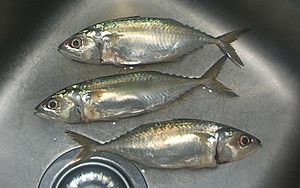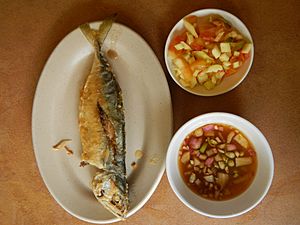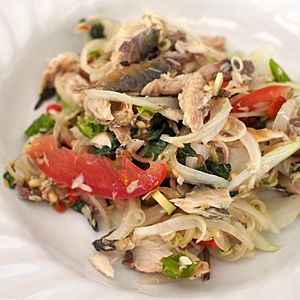Short mackerel facts for kids
Quick facts for kids Short mackerel |
|
|---|---|
 |
|
| Conservation status | |
| Scientific classification | |
| Synonyms | |
|
The short mackerel (Rastrelliger brachysoma) is a type of fish that belongs to the mackerel family. You can find this fish in the shallow waters of Southeast Asia and Melanesia. Short mackerels mainly eat tiny ocean creatures called zooplankton. This fish is very important for the fishing industry in these areas.
Contents
What Does the Short Mackerel Look Like?
The short mackerel can grow up to 34.5 centimeters (about 13.5 inches) long. However, most of them are around 20 centimeters (about 8 inches) long. They become adults when they reach about 17 centimeters (about 6.7 inches) in length. This fish looks like a typical medium-sized mackerel. It has a shiny silver color and a slightly pointed nose.
Where Short Mackerels Live and What They Eat
Short mackerels are pelagic fish. This means they live in the open ocean, not near the bottom. But they like to find food in estuaries, which are places where rivers meet the sea. They prefer water temperatures between 20 and 30 degrees Celsius (68 to 86 degrees Fahrenheit). Their main food source is plankton, which are tiny plants and animals floating in the water.
Short mackerels lay their eggs in batches. Their spawning season, when they reproduce, can last from March to September.
Fishing for Short Mackerel
The short mackerel is a very important fish for people who fish for a living. Fishermen catch them using many different methods. These methods range from using gillnets, which are nets that catch fish by their gills, to other ways of fishing.
Short Mackerel as Food
Short Mackerel in Thailand



In Thai cuisine, the short mackerel is called pla thu (Thai: ปลาทู). It is so common and important that it's sometimes called the "fish of the nation." When sold in markets, pla thu often has its head bent downwards. This gives it a special shape.
People in Thailand usually fry pla thu. They eat it with nam phrik kapi, which is a spicy dipping sauce. They also enjoy it with boiled or raw vegetables. Sometimes, it's served with omelets that have a special plant called cha-om in them. The name pla thu can also sometimes refer to the Indian mackerel.
To prepare pla thu for storage, people first remove the gills. Then, they bend the fish's head forcefully towards its belly. This breaks its backbone. This special way of bending the fish helps three of them fit into a small bamboo basket. Once in the baskets, the fish are boiled for a few minutes. They are cooked in large basins of seawater with salt added. For every 4 liters of water, about 1 kilogram of salt is used.
In Thai cooking, this specially prepared pla thu is often fried. It is eaten with nam phrik kapi, a spicy dip. This dip is made from shrimp paste, dried prawns, lime juice, and fish sauce. It also has small pea eggplants. People eat it with rice and steamed, raw, or fried vegetables.
Pla thu prepared this way can stay fresh for a long time in the refrigerator. In the past, it could last about two weeks without a fridge. This was possible if it was boiled for a few minutes every two days. This method allowed this sea fish to reach many inland places in Thailand. It even reached areas like Chiang Mai in the far north and remote parts of Isan.
Fresh pla thu is also used to make delicious soups. One popular soup is tom yam pla thu. This fish is so loved in Thai culture that the Samut Songkhram F.C. football team has a pla thu on its team symbol.
In 1870, a writer named Anna Leonowens wrote about how important this fish was. She said that the rivers in Thailand had many excellent fish. She noted that plathu was very common and cheap. It was a common addition to a worker's bowl of rice. She also mentioned that Thai people were very good at drying and salting fish. Large amounts were sent to other countries every year.
The insides of this mackerel are a key ingredient in tai pla sauce. This sauce is used to make the famous kaeng tai pla curry.
In 2019, Thailand's National Fisheries Association shared a concern. They warned that short-bodied mackerel might become very rare in the Gulf of Thailand. This could happen if people do not take action to protect them. The Thai Department of Fisheries closes off the upper part of the Gulf of Thailand each year. This happens during the time when short mackerels are breeding. The fish travel from the south of the gulf to the north to find places to lay their eggs. During this time, fishing boats are not allowed in certain areas. However, some local fishermen do not follow this rule. They catch adult female fish during their breeding season. This reduces the number of new fish being born.
In 2011, fishermen caught 147,853 tonnes of pla thu in Thai waters. By 2018, this number had dropped to only 20,461 tonnes. Areas that used to have many fish, like those off Mae Klong, now have very few. Because of this, Thailand often imports mackerel from Sri Lanka and Indonesia. However, many Thais believe that imported mackerel does not taste as good.
Short Mackerel in Other Countries
This type of mackerel is also very important in the food of other parts of Southeast Asia. It is a key ingredient in countries like Cambodia, the Philippines, and Malaysia. In the Philippines, it is the most important type of mackerel caught for food.
See also
 In Spanish: Rastrelliger brachysoma para niños
In Spanish: Rastrelliger brachysoma para niños




